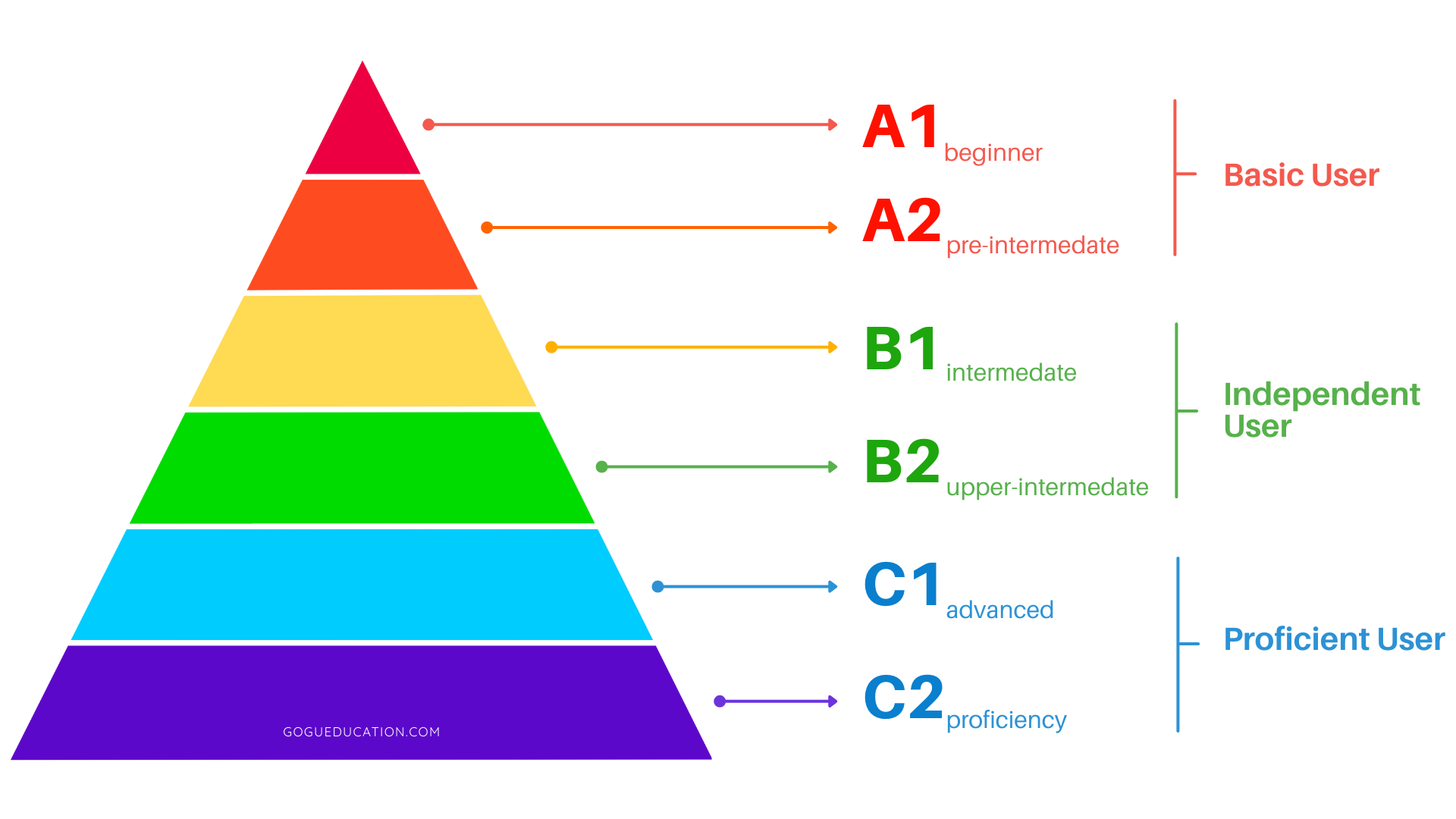What Are CEFR Levels in English?
The CEFR (Common European Framework of Reference for Languages) levels in English are a standardized way to measure a person’s ability to speak and understand English. The system is divided into six levels: A1, A2, B1, B2, C1, and C2. These are grouped into three broad categories:
Basic User (A1–A2)
Independent User (B1–B2)
Proficient User (C1–C2)

The CEFR (Common European Framework of Reference for Languages) is an international standard that describes your ability to use a language like English. It breaks language skills into six levels, from A1 (beginner) to C2 (mastery), helping learners, teachers, and employers understand language proficiency clearly.
A person at this level can:
Can understand and use familiar everyday expressions and very basic phrases aimed at the satisfaction of needs of a concrete type.
Can introduce him/herself and others and can ask and answer questions about personal details such as where he/she lives, people he/she knows and things he/she has.
Can interact in a simple way provided the other person talks slowly and clearly and is prepared to help.
Skills Breakdown:
Grammar:
Uses mostly present tense.
Sentences are short and simple.
Vocabulary:
Knows a few hundred common words.
Depends on context to understand others.
Listening:
Understands slow, simple speech only.
Speaking:
Speaks slowly and carefully.
Uses many fillers like “um” or “uh.”
A person at this level can:
Can understand sentences and frequently used expressions related to areas of most immediate relevance (e.g. very basic personal and family information, shopping, local geography, employment).
Can communicate in simple and routine tasks requiring a simple and direct exchange of information on familiar and routine matters.
Can describe in simple terms aspects of his/her background, immediate environment and matters in areas of immediate need.
Skills Breakdown:
Grammar:
Uses present and some past tenses.
Sentences are simple, but slightly more varied than A1.
Vocabulary:
Knows a few thousand words.
Can talk about familiar topics like family, shopping, jobs, and hobbies.
Listening:
Understands slow, clear speech on everyday topics.
May miss details in longer or fast conversations.
Speaking:
Can take part in short social exchanges.
Can ask and answer questions on familiar topics.
Still speaks slowly, with pauses and occasional errors.
A person at this level can:
Can understand the main points of clear standard input on familiar matters regularly encountered in work, school, leisure, etc.
Can deal with most situations likely to arise whilst travelling in an area where the language is spoken.
Can produce simple connected text on topics which are familiar or of personal interest. Can describe experiences and events, dreams, hopes & ambitions and briefly give reasons and explanations for opinions and plans.
Skills Breakdown:
Grammar:
Uses a range of tenses (present, past, future) with some errors.
Begins using conditionals and relative clauses.
Vocabulary:
Has a broader vocabulary for daily life, work, and personal interests.
May struggle with less familiar or abstract topics.
Listening:
Understands the main idea in everyday conversations or radio/TV programs.
May not catch everything, especially with fast speech or accents.
Speaking:
Can speak clearly on familiar topics.
Can describe experiences, express dreams, and support opinions.
Still makes grammar or vocabulary errors, but communication is usually successful.
A person at this level can:
Can understand the main ideas of complex text on both concrete and abstract topics, including technical discussions in his/her field of specialisation.
Can interact with a degree of fluency and spontaneity that makes regular interaction with native speakers quite possible without strain for either party.
Can produce clear, detailed text on a wide range of subjects and explain a viewpoint on a topical issue giving the advantages and disadvantages of various options.
Skills Breakdown:
Grammar:
Uses complex structures (passives, conditionals, modals, etc.) fairly accurately.
Makes occasional errors, but they don’t hinder communication.
Vocabulary:
Has a broad vocabulary for general and professional topics.
Can express opinions and handle abstract ideas.
Listening:
Understands extended speech and lectures if the topic is familiar.
Can follow most TV shows, films, and conversations without too much effort.
Speaking:
Speaks fluently and naturally in social and professional situations.
Can debate, express thoughts in detail, and adjust language to the situation.
A person at this level can:
Can understand a wide range of demanding, longer texts, and recognise implicit meaning.
Can express him/herself fluently and spontaneously without much obvious searching for expressions.
Can use language flexibly and effectively for social, academic and professional purposes.
Can produce clear, well-structured, detailed text on complex subjects, showing controlled use of organisational patterns, connectors and cohesive devices.
Skills Breakdown:
Grammar:
Uses a wide range of structures accurately and flexibly.
Errors are rare and usually self-corrected.
Vocabulary:
Has a rich, precise vocabulary including idioms and formal language.
Can vary expression depending on tone, audience, and context.
Listening:
Understands extended speech even when it’s not clearly structured.
Can follow films, interviews, lectures, and debates with ease.
Speaking:
Speaks fluently and clearly, adapting style to context.
Can argue a point persuasively and use connectors effectively.
A person at this level can:
Can understand with ease virtually everything heard or read.
Can summarise information from different spoken and written sources, reconstructing arguments and accounts in a coherent presentation.
Can express him/herself spontaneously, very fluently and precisely, differentiating finer shades of meaning even in more complex situations.
Skills Breakdown:
Grammar:
Uses all grammatical structures accurately and naturally.
Can adapt language to any situation or style.
Vocabulary:
Has an extensive vocabulary, including technical, idiomatic, and nuanced language.
Can paraphrase expertly and select precise words for complex ideas.
Listening:
Understands all spoken language, even fast-paced or abstract.
Can follow films, lectures, or conversations with regional accents.
Speaking:
Speaks effortlessly and elegantly, even in high-level academic or professional discussions.
Can switch tone, register, and complexity depending on the audience.